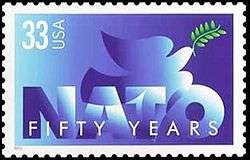Michael Patrick Cronan
Michael Patrick Cronan (June 9, 1951 – January 1, 2013) was an American graphic designer, artist and a Fellow of the American Institute of Graphic Arts. He was one of the founders of the San Francisco Bay Area postmodern movement in graphic design that later became known as the "Pacific Wave".
Early life and education
Cronan was born in San Francisco, California in 1951 and grew up near Sacramento. As a teenager, he learned letterpress printing and had become an artist in a local print shop where he created posters. He then studied at the California College of Arts and Crafts, where he later served as adjunct professor of graphic design from 1981–2001. In 1971, he then went abroad to study archeology, and work as an archaeological dig manager for Hebrew University in the Negev Desert and the at Dead Sea. In 1974 he had received a bachelor's degree in Fine Art from California State University, Sacramento.[1]
Early career
Cronan and partner Karin Hibma established Michael Patrick Cronan Design in 1980.
Cronan was a founding member of the American Institute of Graphic Art (AIGA) chapter in San Francisco and the AIGASF chapter president after serving on the AIGA national board for three years.
Recognition for innovation in graphic design
In 1981 Cronan designed SUSHI, a book that launched a new form of food book. In 1985, Cronan was included with thirty-five American Designers in "Pacific Wave" an exhibition of graphic design curated by Giorgio Camuffo at Museo Fortuny, Venice, Italy.
In 1989 Cronan and Hibma expanded their design palette to include clothing with the creation of the Walking Man, a line of apparel which became the focus of a number of articles and books about designers creating their own products as well as attracting a loyal customer following. In 1992 and 1993 Walking Man clothing won the I.D. Magazine Consumer Product of the Year/Gold Award presented at the Cooper Hewitt National Design Museum, New York.
Also in 1993 Cronan was featured in "In the Public Eye - the work of Four Graphic Designers" including Michael Manwaring, Gerald Reis and Michael Vanderbyl. It was the first graphic design exhibition at the San Francisco Museum of Modern Art (SFMOMA), and its popularity ushered in an expanded presence of graphics in the museum's floor space and permanent collection. In 1998 SFMOMA commissioned Cronan to create the SFMOMA symbol which graphically captures the distinctive oculus at the center of the museum building designed by Mario Botta.

Later that year Cronan created the stamp commemorating the fiftieth anniversary of NATO for the United States Postal Service and later the Prostate Awareness stamp.
In 2002 Cronan's work was included "US Design: 1975-2000," a survey of 250 objects and images first shown at the Denver Art Museum, organized by the Museum's curator R. Craig Miller. ArchNews described the exhibition as "some of the most exciting work produced by American-based designers during the past 25 years."
His graphic design work is currently in the permanent collections of SFMOMA, the Denver Art Museum, the Library of Congress in Washington, DC, The Smithsonian National Postal Museum and London's Victoria and Albert Museum.
Cronan was Chairman of the Board of the Pickle Family Circus, attended the Aspen Leadership Summit in 2005 and served on the Board of the Aspen Design Summit 2005–2006. He created identities for and served on the advisory boards of non-profits such as the Family Violence Prevention Fund - Founding Fathers, among others.
Cronan has been subject of profile articles in Communication Arts Magazine, I.D. Magazine, Linea Graphica (Italy), Graphis Inc., HOW, and many others, and books including Designing Brand Identity: A Complete Guide to Creating, Building, and Maintaining Strong Brands, A History of Graphic Design, Meggs, Making Graphic Design History and The Design Entrepreneur, Graphis Brand. His award-winning work has been published extensively in graphic design annuals and other publications. He has spoken to design communities and judged design competitions throughout the United States and internationally.
Cronan was an accomplished fine artist and regularly exhibited his artwork, as well as doing private commissions. His work can be seen at . From 2005, Cronan focused on creating names, visual identities and brand strategies for new products, companies and emerging technologies. In June 2009, he and Karin Hibma were named two of Fast Company's list of 100 Most Creative People in Business.[2]
Death
On January 1, 2013, Cronan died at his Berkeley home after a long battle with cancer. He had been diagnosed for the same for five years previously.[3] He was 61 at the time of his death.
References
- Profile Archived 2015-01-17 at the Wayback Machine, whatwilltheylearn.com; accessed March 9, 2015.
- "100 Most Creative People in Business 2009". Fast Company. Retrieved 2020-01-22.
- Notice of death of Michael P. Cronan